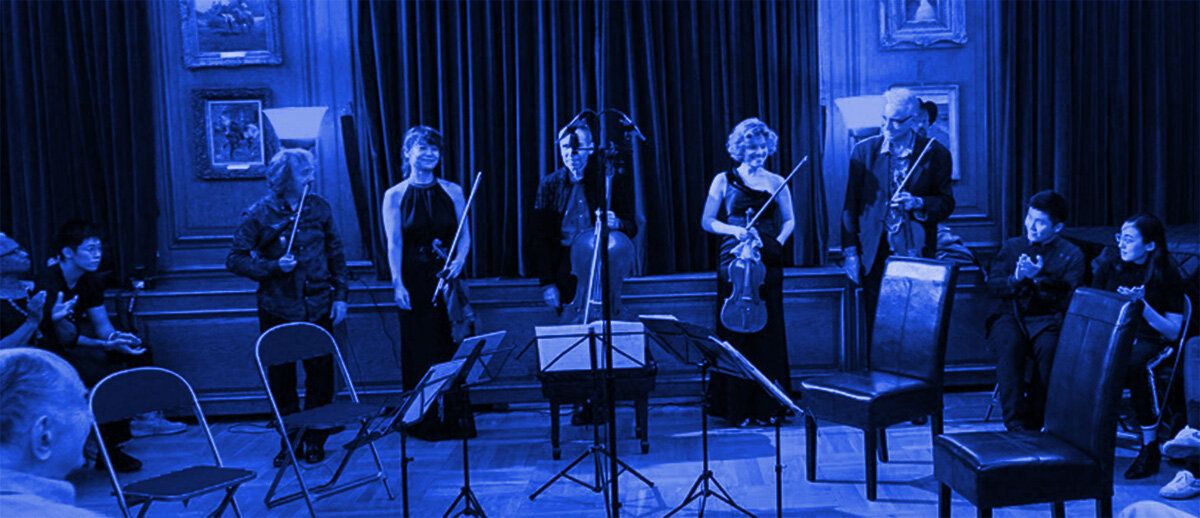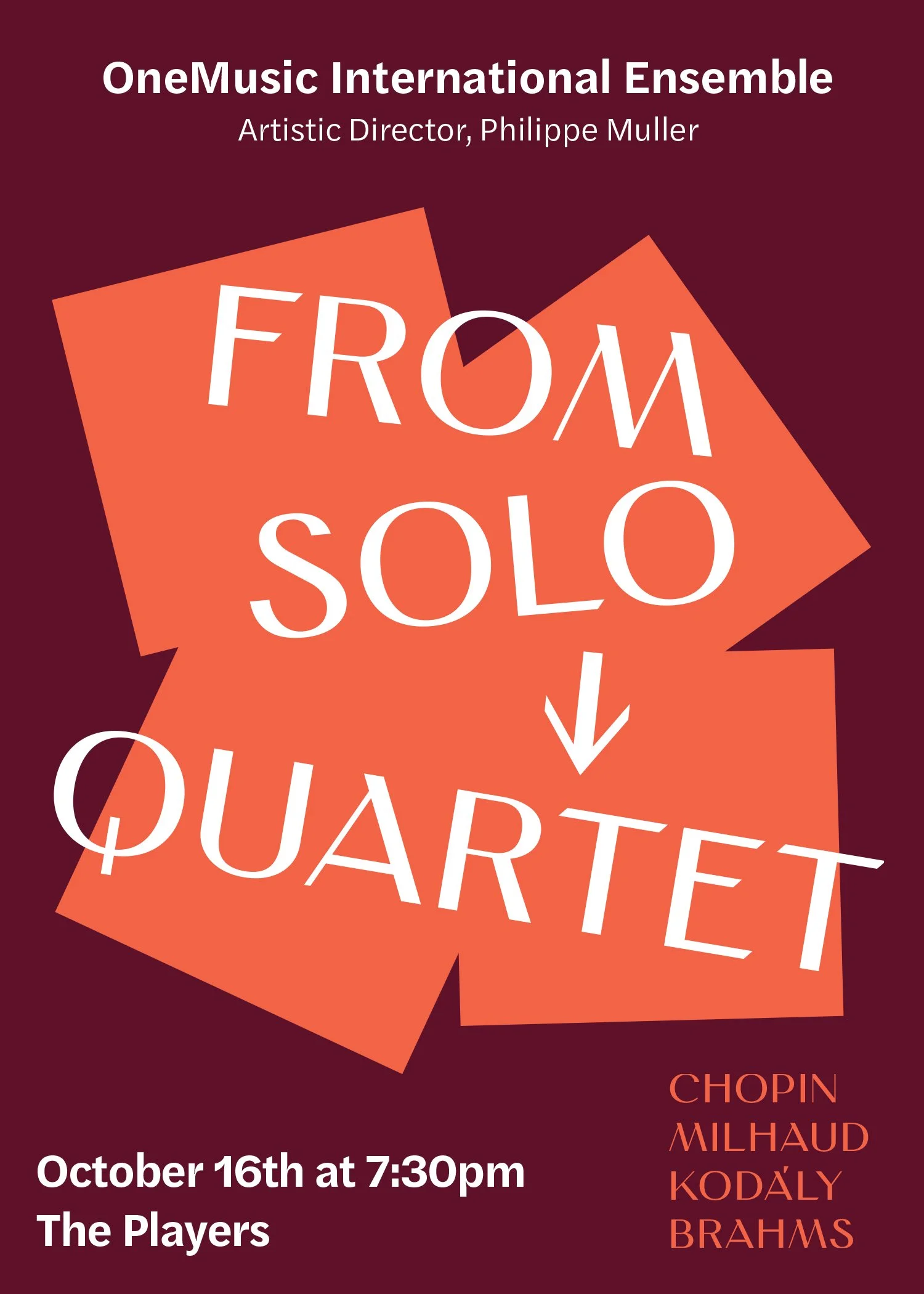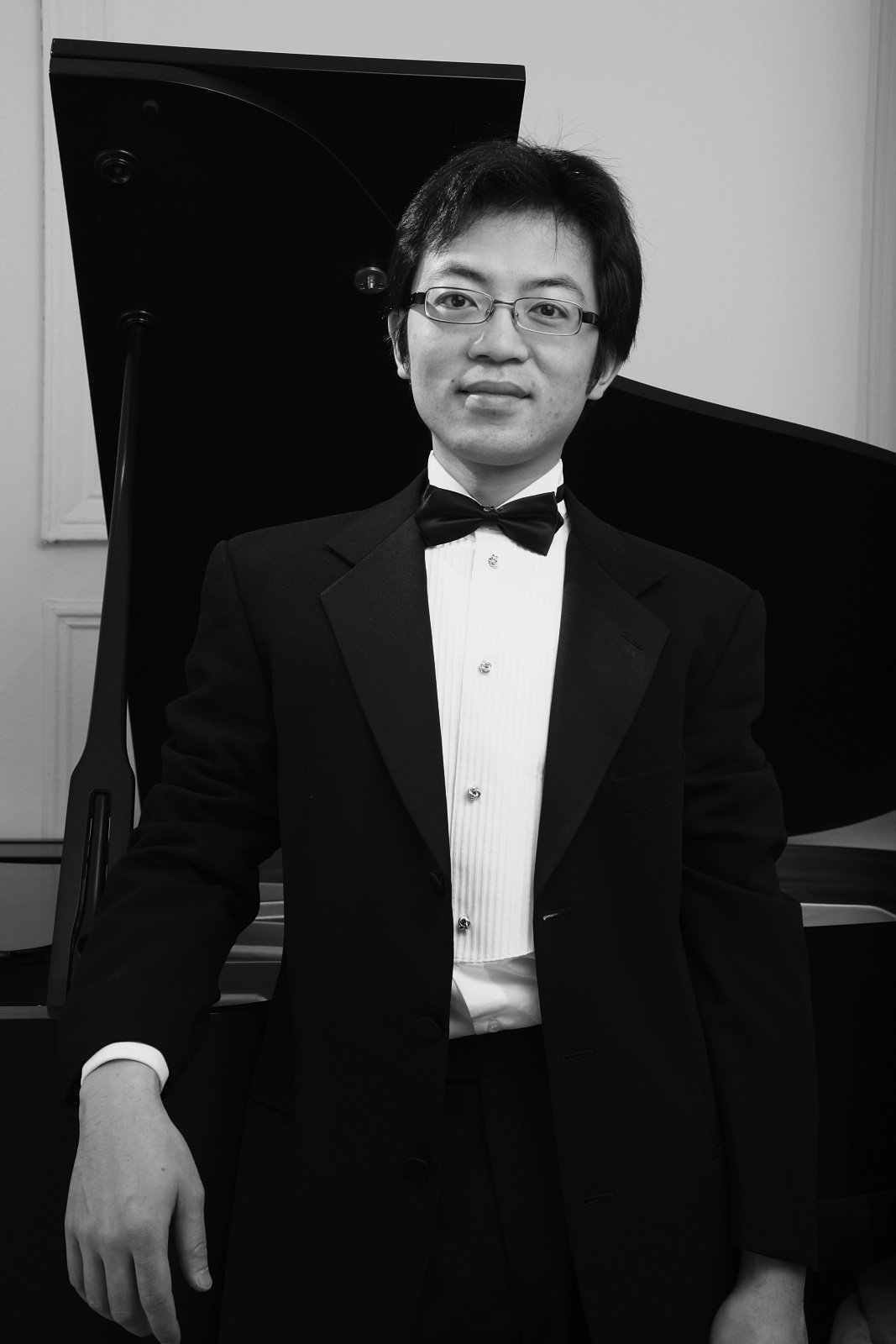Concert Program
OneMusic International Ensemble
From Solo → Quartet
Oct. 16, 2025
Yibin Li - violin
Philippe Muller - cello
Daniel Panner - viola
Chung-Hsi Hsieh - piano
Barcarolle in F sharp, op.60
Frederic Chopin (1810-1849)
Sonatine for violin and cello
Darius Milhaud (1892-1974)
I. Animé
II. Modéré
III. Vif
String Trio-Intermezzo
Zoltán Kodály (1882-1967)
Intermission
Piano Quartet no.1 in G minor, op.25
Johannes Brahms (1833-1897)
I. Allegro
II. Allegro ma non troppo
III. Andante con moto
IV. Prest - Rondo alla Zingarese
OneMusic International Ensemble
From Solo → Quartet
Oct. 16, 2025
Yibin Li - violin
Philippe Muller - cello
Daniel Panner - viola
Chung-Hsi Hsieh - piano
Barcarolle in F sharp, op.60
Frederic Chopin (1810-1849)
Sonatine for violin and cello
Darius Milhaud (1892-1974)
I. Animé
II. Modéré
III. Vif
String Trio-Intermezzo
Zoltán Kodály (1882-1967)
Intermission
Piano Quartet no.1 in G minor, op.25
Johannes Brahms (1833-1897)
I. Allegro
II. Allegro ma non troppo
III. Andante con moto
IV. Prest - Rondo alla Zingarese
The Artists
Yibin Li
Yibin Li was born in Jiuquan, China, a small city near the Gobi Desert. When she was just 4 1/2, she began playing the violin under the guidance of her father. Just 7 years later, she left home to study at Xi’an Conservatory, where she remained until moving on to Shanghai Conservatory. Upon her graduation, she was appointed to the violin faculty, and taught in Shanghai for six years as a young member of the tenured faculty. At 26, she felt the need to continue her studies in the US and moved to New York, where she went on to earn two additional graduate degrees at The Juilliard School and Mannes School of Music. Her teachers have included Lewis Kaplan, Seymour Lipkin, Earl Carlyss, Peiwen Yuan and Xiaolong Liu.
Ms. Li has performed as a soloist with major symphonies in China and the US, including the Beijing National Symphony Orchestra, Shanghai Symphony Orchestra, Taipei Symphony Orchestra, Gaoxiong Symphony Orchestra, San Diego Symphony, Hunter Symphony and Syracuse Symphony Orchestra. She was the first violinist and founder of the Iris String Quartet, and the founder of French-American Ensemble, and has directed and played chamber music concerts in many New York City venues including Carnegie Hall, Alice Tully Hall, Merkin Hall and Scandinavia House. In China, she traveled to over 20 cities performing both solo and chamber concerts in major performing arts centers.
Ms. Li performs and teaches regularly at summer music festivals including the Bowdoin International Music Festival and Bach Virtuoso Festival in Maine., the LaSalle Music Festival in France, Sesto Rocchi Chamber Music Festiva in Italy and the Lake Lugano Chamber Music Festival in Switzerland.
Yibin Li is currently on the faculties of Mannes School of Music and The Juilliard School Pre-College Division, and is a visiting professor in China at the Xi’an Conservatory of Music and Beijing Central University for Normal Studies.
Philippe Muller
Born in Alsace, Philippe Muller was raised in both the French and German musical traditions that characterize that province. His early experiences opened his mind to varying cultures and lead him to a multi-faceted career. He performs and has recorded a wide range of repertoire, from the Bach Suites, through the music of living composers.
In 1970, Mr. Muller founded a Piano Trio with pianist Jacques Rouvier and Jean- Jacques Kantorow, violin, which was widely known to be one of Europe’s most venerated chamber music ensembles. He worked closely with Pierre Boulez’ Ensemble Intercontemporain, for seven years, giving him an understanding of and an affinity for the music of our time. He continues to be active in commissioning new cello works and premiers of new music and performs frequently as soloist and in various chamber music ensembles at festivals in Europe, the United States, Canada, Latin America, Japan, Korea, Australia and New Zealand.
Philippe Muller’s teaching career is legendary. He succeeded his mentor André Navarra as cello teacher at the Conservatoire de Paris in 1979, continues his teaching legacy today here in New York, at the Manhattan School of Music. Many cellists from his studio have gone on to major careers as soloists including Xavier Phillips and Gautier Capuçon. He travels often giving master-classes in the top conservatories across the globe and has spent twenty years teaching at the Academy of French Music in Kyoto, Japan.
Philippe Muller frequently serves on the juries of the major international cello competitions such as the Tchaikovsky in Moscow, Paulo in Helsinki and Rostropovitch in Paris.
Daniel Panner
Daniel Panner enjoys a varied career as a performer and teacher. As violist of the Mendelssohn String Quartet, he concertized extensively throughout the United States and Israel. He has performed at numerous music festivals, including Marlboro, Ravinia, Tanglewood and Aspen, and he has collaborated with members of the Cleveland, Emerson, Guarneri and Juilliard String Quartets. As a member of the Whitman String Quartet, Mr. Panner received the 1998 Walter W. Naumburg Chamber Music Award and served as a teaching assistant to the Juilliard String Quartet for two years.
Mr. Panner is co-chair of the string department of the Mannes College of Music, where he also teaches viola and chamber music. He has also taught at the Juilliard School, Rutgers University, SUNY Stonybrook, Queens College, and the Jerusalem Music Center Summer Courses, and he has given master classes at such schools as Peabody, Hartt and the North Carolina School of the Arts. He has performed with the Chamber Music Society of Lincoln Center, the Metropolitan Opera Orchestra, the New York Philharmonic, and the Orchestra of St. Lukes; he has also toured with Musicians from Marlboro and the Orpheus Chamber Orchestra. As a guest artist, he has performed with the Juilliard String Quartet, the St. Lawrence String Quartet, the Daedelus String Quartet, the Flux String Quartet and the Moscow Conservatory Trio. Mr. Panner has been heard on National Public Radio's "Performance Today," both as a soloist and chamber musician. He has served as the principal violist of such orchestras as the New York City Opera and the Mostly Mozart Festival Orchestra. An active performer of new music, he is a member of Sequitur and the Locrian Ensemble and has performed as guest with such new-music groups as Speculum Musicae, the Da Capo Chamber Players, and Transit Circle; he has recorded solo viola works by Thea Musgrave and Victoria Bond, both for Albany Records. Mr. Panner studied with Jesse Levine at Yale University, where he earned a bachelor's degree in history. He continued his studies at the Curtis Institute of Music with Joseph dePasquale and the Juilliard School with Samuel Rhodes.
Chung-Hsi Hsieh
Pianist Chung-Hsi Hsieh is from Taiwan. He won top prizes in the Nena Wideman International Piano Competition, Taipei International Chopin Competition, Taiwan Concerto Competition, Corpus Christi Young Artists Competition, and Fischoff National Chamber Music Competition. He has appeared in renowned recital halls such as Carnegie Weill Recital Hall, Merkin Hall, Klavierhaus, and Steinway Hall, in New York City, as well as the National Recital Hall in Taiwan. As a chamber musician he often collaborates with the principles of Boston Symphony Orchestra, Berlin Deutsches Symphonie Orchester, San Diego Symphony Orchestra, and A Far Cry Chamber Orchestra. Mr. Hsieh has performed recitals in Boston, Los Angeles, Beijing, Shanghai and Shenyang. He was a young artist at the Irving Gilmore International Keyboard Festival in Kalamazoo, MI, as well as Kneisel Hall Chamber Music Festival.
After winning the top prize from Taiwan National Music Competition in 1991, he was awarded the opportunity to continue his musical studies in USA where he obtained his high school diploma from Interlochen Arts Academy, BM and MM from The Juilliard School, and DMA from Rutgers, The State University of New Jersey. His principle teachers were Victoria Mushkatkol, Seymour Lipkin, and Susan Starr. During this time he also worked with Lynn Harrell, Lewis Kaplan, Arnold Steinhardt, Jane Coop, and Douglas Lundeen.
Mr. Hsieh started his musical training on the piano at age 4. He also learned violin, and Erhu, a traditional Chinese instrument when he entered the music training class at age 9. At a young age he already showed his musical talent, as he frequently won competitions on piano and violin, and he started performing as soloist and conductor, leading the school symphony orchestra, Chinese instrument orchestra and school choir to public performances.
Currently he is a piano and music faculty at the Diller-Quaile School of Music. Besides honing his craft and working with aspiring talents, Chung-Hsi also enjoys exploring culinary arts and fine wine around the world.
Program Notes
Frederic Chopin (1810-1849)
“I should like now to finish my violoncello sonata, barcarolle and something else I don’t know how to name,” wrote Chopin in a letter of December 1845. Working through debilitating illness and the grinding conclusion of his unhappy relationship with the writer George Sand, Chopin published in the following summer his Barcarolle, Op. 60 and the “something else” known eventually as the Polonaise-Fantasie, Op. 61—consecutive towering masterpieces of his final years.
Drawn from two Italian words, barca or boat, and rollo or rower, the barcarolle was a beloved 19th-century cliché: the gently rocking romantic songs of Venetian gondoliers. Chopin’s Barcarolle is anything but that. Working with a broad 12/8 time signature, Chopin’s watery undulations begin calmly, but upon their return in the final third of the piece, build like the immense swells of the open ocean—no moonlit canal scene here, but a relentless and dramatic escalation.
- Grant Hiroshima
Darius Milhaud (1892-1974)
Composed in 1953, Darius Milhaud’s Sonatine for Violin and Cello is a compact yet vibrant work that captures the essence of his mature style. Known for his innovative use of polytonality—the simultaneous use of multiple keys—Milhaud blends rhythmic vitality and crystalline counterpoint within a neo-classical framework.
In this Sonatine, the violin and cello engage as equals, their lines intertwine and converse, creating a lively and intricate dialogue where melody and rhythm pass seamlessly between the two instruments. This interplay highlights Milhaud’s skill in balancing clarity with complexity.
Throughout the work, energetic and syncopated rhythms drive the outer movements, while moments of lyrical warmth and wit portraits Milhaud’s distinctive French sensibility. The transparent textures reveal his mastery of counterpoint, allowing each voice to remain distinct while contributing to a cohesive whole.
- Yibin Li
Zoltán Kodály (1882-1967)
Zoltán Kodály was one of Hungary’s most influential musical figures — a composer, scholar, educator, critic, and pioneering ethnomusicologist. Alongside his close friend Béla Bartók, he spent years collecting and studying authentic Hungarian folk songs, preserving them from the stylized “gypsy” versions popular in European salons. Their fieldwork laid the foundation for a new national musical language rooted in genuine folk tradition.
Kodály’s Intermezzo for String Trio (1905) dates from the period just after his graduation from the Budapest Academy of Music, before his first major research trips with Bartók. Though an early work, it already reveals his affinity for folk-inflected melody and lyrical warmth.
Written in a simple A–B–A form, the five-minute Intermezzo has the charm of a light serenade. The opening section features a graceful violin melody over a pizzicato accompaniment reminiscent of the zither, a traditional Central European instrument. The middle section turns more lyrical and expressive before returning to the tranquil opening mood.
- Willard J. Hertz
Johannes Brahms (1833-1897)
Piano Quartet No. 1 in G minor, op. 25 (1861) /Orchestrated by Arnold Schoenberg (1937)
In a series of lectures from 1947 entitled “Brahms the Progressive,” Arnold Schoenberg related an instance of Brahms dealing with one of his fans. “Contemporaries found various ways to annoy him,” writes Schoenberg of Brahms. “A musician or a music lover might intend to display his own great understanding, good judgment of music, and acquaintance with ‘some’ of Brahms’ music. Hence he dared say he had observed that Brahms’ First Piano Sonata was very similar to Beethoven’s ‘Hammerklavier’ Sonata. No wonder that Brahms, in his straightforward manner, spoke out: ‘Every jackass notices that!’
Such comparisons followed Brahms throughout his career—his First Symphony was dubbed “Beethoven’s Tenth.” Yet Schoenberg saw Brahms not as a conservative heir, but as an innovator. His concept of “developing variation”—continuously transforming musical ideas as they unfold—was, to Schoenberg, a mark of true modernity.
Brahms composed his Piano Quartet No. 1 in G Minor in 1861, a work of passion, structural mastery, and Hungarian flair. In 1937, Schoenberg orchestrated it for full orchestra, giving the world a new way to hear Brahms’ chamber masterpiece. “I like the piece,” Schoenberg wrote, “but it’s seldom played—and always badly. I wanted to hear everything, and this I achieved.”
The orchestration retains Brahms’ warmth and lyricism while expanding its color palette. From the noble opening to the fiery Gypsy Rondo finale, Schoenberg’s version illuminates Brahms’ textures with symphonic brilliance—an inspired collaboration across generations that reveals, indeed, “Brahms the Progressive.”
– John Mangum

We need your help
Your contributions are essential to our mission of reaching more people with the extraordinary experience of live chamber music.
Thank you for making it happen.
OneMusic Project acknowledges the generous support of the following individuals for their time, gifts, and financial support. With their help, we are able to realize our mission of bringing great artists from Europe and the USA together to perform in our community.
Please join our partnership today by giving to OneMusic Project today!
OneMusic Project is grateful for support from
James & Susan Aisenberg
Veronique Brossier
Chu Family Foundation
Dan Kainen & Karen Dorst
Robert & Nina Kaufelt
Loube-Li Family
Philippe Muller
Alexander Ommaya
The Morris and Alma Schapiro Fund
Robert Spitzer
Richard Holley
Susanne & Frank Hugus
Wei Family
Joseph Towbin
Individual Contributors
Brian Loube
Ellen Oppenheim
Betsy Mulberry
Zoe Lo
Liza Loube
Ben Young
Eric Sandell
Jeff Vock





